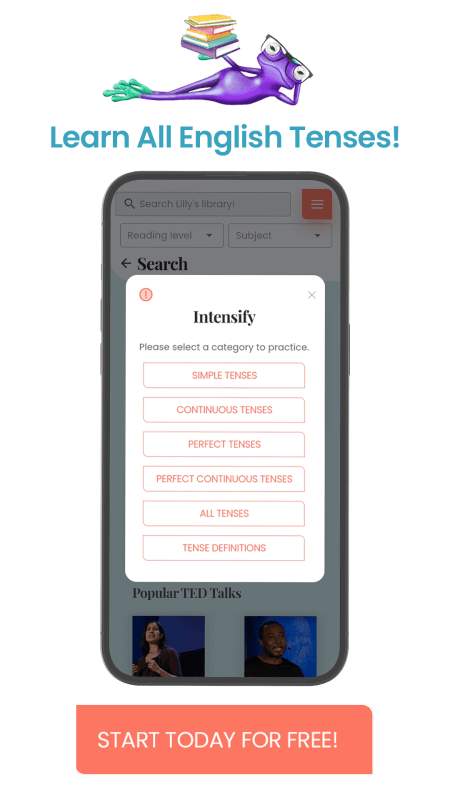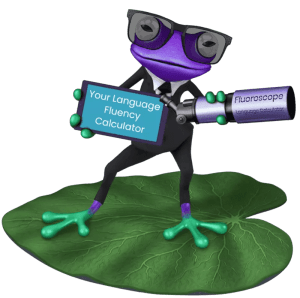Tenses Rules with Examples & Chart
One core skill to master when learning the English language is grammar. Among the components of grammar, tenses are integral but challenging to grasp for learners. Tense is the time reference in a sentence —it signifies when an action happens.
There are three major groups of tenses: present, past, and future. In dealing with tenses, one has to always consider the verbs. Most importantly, follow the subject-verb agreement rule, which states that the verb agrees in number (singular or plural) with its subject. Additionally, note the verb forms following the tense it follows.
In this blog, we will demystify tricky tenses rules, understand verb forms, and master the sequence of tenses.
Unlocking Verb Tenses Terminologies
Before diving deep into tenses, let’s understand the key terminologies below to help you better grasp the concepts.
- Object: the object of the sentence refers to the person, place, or thing being acted by the verb. In short, it is the receiver of the action.
- Subject: in contrast with the object, the subject is the doer of the action.
- Tense: a tense is a time reference of action.
- Verb: a verb is a word used to express an action.
- V1: the first form of a verb (V1) is its base form.
- V2: verb-second (V2) is the simple past form (past tense) of verb tenses.
- V3: verb in the third form (V3) is in the past participle form.
Types of Tenses
There are three types of tenses in English grammar. The present tense indicates an action that is currently happening or is continuous or habitual. An act or event was in the past tense if it happened already. It is usually signaled by the words like yesterday, earlier, in 2001, last night/ week/ weekend/ month/ year, and a week/ month/ year ago. Lastly, action is in the future tense if it will happen shortly, soon, or in the future. This can be indicated with the word tomorrow, next week/ month/ year, later, and N years from now.
All Tenses Rules
The tenses of verbs extend to four categories: simple, perfect, continuous or progressive, and perfect continuous. In total, there are 12 types of tenses rules in English grammar that learners must master. The grammar section of competitive examinations usually includes tense subjects, so it is necessary to know all these rules. Below is the rule of tense chart that breaks down the 12 sentence structures or tense formula:
| Present Tense | Sentence Structure or Formula |
| Simple Present Tense | Singular Subject + (V1 + s/es) + Object Plural Subject + V1 + Object |
| Present Perfect Tense | Singular Subject + has + V3 + Object Plural Subject or First Person and Plural Third Person Pronouns I/ You/ We/ They+ have + V3 + Object |
| Present Continuous Tense | Subject + is/am/are + (V1 + ing) + Object |
| Present Perfect Continuous Tense | Subject + is/am/are + (V1 + ing) + Object Plural Subject + have been + (V1 + ing) + Object |
| Past Tense | Sentence Structure or Formula |
| Simple Past Tense | Subject + V2 + Object |
| Past Perfect Tense | Subject + had + V3 + Object |
| Past Continuous Tense | Singular Subject + was + (V1 + ing) + Object Plural Subject + were + (V1 + ing) + Object |
| Past Perfect Continuous Tense | Subject + had been + (V1 + ing) + Object |
| Future Tense | Sentence Structure or Formula |
| Simple Future Tense | Subject + will/shall + V1 + Object Subject + am/is/are + going to + V1 + Object |
| Future Perfect Tense | Subject + will have/shall have + V3 + Object |
| Future Continuous Tense | Subject + will be/shall be + (V1 + ing) + Object |
| Future Perfect Continuous Tense | Subject + will have been + (V1 + ing) + Object |
The types of tenses formula and examples are further explained below:
Present Tense Rules
The present tense is grammatical construction used to express an ongoing or habitual action, state of being, and facts. Every rule for present tense is explained below:
Simple Present Tense Rules
Simple present or indefinite tense follows the tense structure:
Singular Subject + (V1 + s/es) + Object
Plural Subject + V1 + Object
Examples of Simple Present Tense:
- Habitual action with a singular subject: Olivia drinks coffee every morning.
- Habitual action with a plural subject: The children play basketball on weekends.
- State of being with a singular subject: Lea feels great.
- State of being with a plural subject: The lawyers live in New York City.
- Fact with a singular subject: A liquid takes the shape of a container.
- Fact with a plural subject: Birds lay eggs.
As observed above, the simple present tense expresses a habitual action, state of being, and facts.
Present Perfect Tense Rules
The present perfect tense is easily identifiable as it always contains the auxiliary verbs has and have. There are two conditions governing the present perfect tense. First, it is used to show actions that started or had happened in the past. And second, those actions continue or affect the present. This verb tense follows this structure:
Singular Subject or Pronouns He/ She/ It + has + V3 + Object
Plural Subject or First Person and Plural Third Person Pronouns I/ You/ We/ They+ have + V3 + Object
Examples of present perfect tense with a singular subject:
- He has traveled in Europe since 2015.
- Daisy has walked to the University.
- My mother has baked a cake for your birthday.
Examples of present perfect tense with a plural subject or first person and plural third person pronouns:
- I have waited for your call.
- The wolves have eaten the chickens.
- Companies have created phones with built-in disaster alert systems.
Present Continuous Tense Rules
The present continuous or progressive tense indicates that an action or situation is occurring right now, often, and will likely continue into the future.
Present continuous tense follows the tense structure:
Subject + is/am/are + (V1 + ing) + Object
Examples of present continuous tense:
- They are writing essays to practice for their competitive exam.
- Benjamin is waiting for a taxi while Penny is talking to her friend.
- I am reserving plane tickets for our vacation.
- He is reading the newspaper while eating his breakfast.
- My friends are reviewing for their competitive exam tomorrow.
Present Perfect Continuous Tense Rules
The present perfect continuous or present perfect progressive tense shows an action that has begun sometime in the past and continues in the present. Meaning the action is not completed yet. Hence, the subject is still performing it in the present.
Present perfect continuous tense follows the tense structure:
Singular Subject + has been + (V1 + ing) + Object
Plural Subject + have been + (V1 + ing) + Object
Examples of present perfect continuous tense with a singular subject:
- Katrina has been painting her room for three weeks.
- He has been convincing her to hire a professional painter.
- A bird has been building a nest here for the past hour.
Examples of present perfect continuous tense with a plural subject:
- The cats have been roaming around the house to search for food while she is away.
- They have been looking for answers to why she left.
- Fatima and her friends have been organizing her surprise birthday party for a week now.
Past Tense Rules
The next types of tenses we will uncover are the categories of past tense. It shows that an action or event happened or already occurred.
Simple Past Tense Rules
The simple past tense is part of the indefinite tense used to show a completed or finished action. This verb tense is also used to convey the subject’s past state of being. It also uses the second form of the verb.
Simple past tense follows the tense structure:
Subject + V2 + Object
Examples of simple past tense:
- They played football yesterday.
- The awarding ceremony was the highlight of his day.
- Our friends ate dinner at a famous restaurant.
- She cleaned the kitchen yesterday.
- Joe typed his accomplishment report.
Past Perfect Tense Rules
When two actions happened in the past, the past perfect tense denotes which activity occurred first. The third form of the verb or the past participle form is used to indicate the tense of the main verb.
Past perfect tense follows the tense structure:
Subject + had + V3 + Object
Examples of past perfect tense:
| First Action | Second Action |
| The students had finished answering the competitive exam | before the earthquake happened. |
| I had cooked dinner | when he arrived with takeout from Olive Garden. |
| The squirrel had eaten the nuts I placed on the feeder | before the cardinals arrived. |
| We had deleted the recording of the football yesterday | when they told us to send it. |
| Tom had cleaned the kitchen yesterday | because Marie did not tidy up when she left. |
Past Continuous Tense Rules
The past continuous tense displays a recurring action in the past. It means that an event repeatedly happened until it stopped. Following the tense rules, the base form of the verb (V1) with the suffix -ing is used.
Past continuous tense follows the tense structure:
Singular Subject + was + (V1 + ing) + Object
Plural Subject + were + (V1 + ing) + Object
Examples of the past continuous tense of a verb with a singular subject:
- I was reading a novel this morning.
- She was doing errands at 9:00 am.
- Lilly was biting her nails until her mom told her to stop.
Examples of the past continuous tense of a verb with a plural subject:
- The bees were pollinating the flowers in summer.
- The students were studying the past participle form of verbs during the first quarter.
- We were talking on the phone before midnight.
Past Perfect Continuous Tense Rules
The past perfect continuous tense shows that an action started, continued, and finished at some point in the past. It describes a situation or a process that began previously and continues at some point before the present. Moreover, it is used to express the duration and the cause of something in the past.
Past perfect continuous tense follows the tense structure:
Subject + had been + (V1 + ing) + Object
Examples of past perfect continuous tense:
- She had been reviewing for the college exam for two weeks.
- I had been studying English for three years before I passed my TOEFL test.
- Teddy had been driving all day, so he was tired.
- It had been raining for an hour.
- Clara and her friends had been shopping for about two hours when her mother called.
Future Tense Rules
The four types of tenses under the future tense show a future event, action, or state of being. In short, the future tense describes something that will happen in the future. The rules of tenses under this category are explained below:
Simple Future Tense Rules
The simple future tense is an indefinite tense – it does not specify a time when something will happen. It is used to express intentions with no exact time when it will happen.
Simple future tense follows the tense structure:
Subject + will/shall + V1 + Object
Examples of simple future tense:
- I shall start a minimalist lifestyle.
- She will respond to the letter.
- John will learn to speak with perfect grammar.
- They shall attend the ceremony.
- He will leave this city for work.
Another tense structure for simple future tense is:
Subject + am/is/are + going to + V1 + Object
Examples of simple future tense with the “going to” structure:
- I am going to buy a new phone.
- The cat is going to eat your food if you don’t cover it.
- We are going to visit Hawaii.
Future Perfect Tense Rules
The future perfect tense expresses an action that will be completed before another point in the future. It indicates the completion of an event in the future.
Future perfect follows the tense structure:
Subject + will have/shall have + V3 + Object
Examples of future perfect tense:
- The band will have started playing her favorite song by the time she leaves the office.
- Her teacher will have collected the exam papers before he figures out the 3rd person singular pronouns.
- Selma shall have written the report before the weekend.
- I will have left the house by the time the package arrives. Please receive it for me.
- The teacher shall have prepared the English grammar questions this afternoon.
Future Continuous Tense Rules
The future continuous or progressive tense describes an ongoing action in the near future. There is an exact time that shows certainty for an activity to happen.
Future continuous tense follows the tense structure:
Subject + will be/shall be + (V1 + ing) + Object
Examples of future continuous tense:
- Mila shall be working on a new project next week.
- I will be doing my assignment tonight.
- They shall be playing football next season.
- The dog will be fetching the ball when I throw it.
- Ken will be attending school tomorrow.
Future Perfect Continuous Tense Rules
The future perfect continuous tense shows an action that will continue at some point in the future. It shows that something is in progress and will be accomplished in the future.
Future perfect continuous tense follows this sentence structure:
Subject + will have been + (V1 + ing) + Object
Examples of future perfect continuous formula in a sentence:
- Andy will have been living here for a year by June.
- We will have been waiting for the bus for thirty minutes at seven o’clock.
- Ben will have been speaking on the phone for an hour by noon.
- My friends will have been finishing their senior year in three months.
- By dinner time, he will have been trying to fix the laptop for two hours.
Tenses Rules & Application
The twelve types of tenses pose a challenge to memorize as some rules look the same. In this tense chart with rules, you will see the sequence of tenses and examples of how to use them properly.
| The 12 Tenses | Tenses Rules or Application | Tenses in English Grammar with Examples |
| Simple Present Tense | facts habitual action state of being future event that is part of a schedule when sentences starts with “here” or “there” |
Lemons float when dropped in water. The ladies practice yoga every morning. Dan feels hungry. The flag ceremony starts at 9:00 a.m. Here comes the sun! There goes my everything. |
| Present Perfect Tense | completed action in the immediate past affecting or expected to continue in the present | The teacher has walked out the room. I have made four lesson plans by now. Lisa has solved a set of calculus problems since this evening. |
| Present Continuous Tense | action that is happening in the moment shows developing situations |
She is deciding on where to eat for lunch. The weather is getting brighter as the hours go by. |
| Present Perfect Continuous Tense | action that has begun sometime in the past and continues in the present | I have been managing this business for six months. |
| Simple Past Tense | expresses a completed or finished action sentences with implied adverb of time |
They announced the details of the competition. I arrived late at the office (yesterday). |
| Past Perfect Tense | denotes which activity occurred first between two past actions | Vina had consulted a lawyer before she met with her business partners. |
| Past Continuous Tense | displays a recurring action in the past habits in the past |
We were practicing our dance routine last night. He was always smoking a cigarette. |
| Past Perfect Continuous Tense | shows that an action started, continued, and finished at some point in the past | Leo had been encouraging me to join a singing competition. |
| Simple Future Tense | expresses intentions with no exact time on when it will happen | I will jog at the park. I am going to run with my dogs. |
| Future Perfect Tense | gives certainty that an action will be completed in the future | I will have developed a module for tenses by Tuesday. |
| Future Continuous Tense | represents an ongoing action in the near future expresses planned events or appointments |
Mia will be installing the software by then. The plumber shall be fixing the leakage on the sink at 3:00 p.m. |
| Future Perfect Continuous Tense | describes an ongoing action to be completed in the near future | Sian will have been saving for a new car for six months in August. |
Tenses Rules Practice Exercises
A. Fill in the blanks with the correct form of the verb to complete the sentences following the present tense rules below:
1. She __________ for her thesis. (research)
2. They have ___________ a promising proposal. (submit)
3. The professor has been ______________ their papers. (check)
4. He has ____________ the concept to the students. (explain)
5. The students ____________ their notes. (review)
B. Complete the sentences in the past tense below:
1. He ____________ to copy my output. (try – simple past tense)
2. Carl _______________ setting the table when his guests arrived. (finish – past perfect tense)
3. The dogs _______________ at the visitors all evening. (bark – past continuous tense)
4. I __________________ Netflix for two hours. (watch – past perfect continuous)
5. We _________________ away from the riot before the police arrived. (run – past continuous tense)
C. Identify the correct future tense of the sentences below:
1. I shall (print, printed, printing) the blueprint of the building.
2. Tad and Lilly are (going to attended, going to attend, go to attending) the party.
3. We will (will have closed, will have been closing, will have close) the doors by the time they arrive due to the traffic.
4.He (shall be returned, shall have been return, shall be returning) your book next week.
5. The accountant (shall explain, will have been explaining, was going to explained) her taxes for an hour at two in the afternoon.
Answers:
| A | B | C |
| 1. researches | 1. tried | 1. print |
| 2. submitted | 2. had finished | 2. going to attend |
| 3. checking | 3. were barking | 3. will have closed |
| 4. explained | 4. had been watching | 4. shall be returning |
| 5. review | 5. were running | 5. will have been explaining |
Conclusion
There are various rules and concepts one has to learn the English language. The twelve different tenses are among those rules. It can be hard to memorize. But remember that the form of the verb should always agree with the subject of the sentence. Moreover, tenses indicate the time frame in which an action happened. It can be in the present, past, or future tense.
Simple tenses are the basic forms of a verb. It shows actions that happen at a certain point in time. On the other hand, perfect tenses express activities that have been completed or perfected. Additionally, continuous represents undertakings that are in progress. Finally, perfect continuous tenses denote something that started and is progressing at a given time.
Frequently Asked Questions
You can learn tenses easily by examining and understanding the tenses rules chart. It summarizes the application of tenses and their sentence structure. Aside from that, you can write your own sentences as you study to better remember the rules.
The V represents the word verb, while the numbers mean the form of verbs used in a sentence. The first form of a verb (V1) is its base form. Meanwhile, the verb-second (V2) is the past simple form of verb tenses. Lastly, the verb in the third form (V3) is in the past participle form.
The three forms of tense are the present tense, the past tense, and the future tense. They show the time frame in which the action happens. When an event happens at the moment, it is in the present tense. If it occurred before now, then it is in the past tense. Finally, the future tense shows something is yet to happen but will sometime in the future.
Yes, the English language has 12 major tenses of verbs. Those tenses are (1) simple present tense, (2) present perfect tense, (3) present continuous tense, (4) present perfect continuous tense, (5) simple past tense, (6) past perfect tense, (7) past continuous tense, (8) past perfect continuous tense, (9) simple future tense, (10) future perfect tense, (11) future continuous tense, and (12) future perfect continuous tense.
There are 12 major tenses of verbs in the English language. The most common ones are present, past, and future. Those are further categorized into simple, perfect, continuous, and perfect continuous tenses.
You can easily identify tenses by noting the form of the verb used in a sentence and the auxiliary verbs beside it. For example, when V1 is used, it is most likely to be in the simple present tense. If the V1 is preceded by will or shall, then it is in the future perfect tense.
The best way to learn tenses is to study one category at a time. You can start by unlocking all the present tenses first before moving on to the next. Structuring your study this way lessens the confusion you might face. You can also remember the tenses by making “now” the point of time reference. The present tense is now. The past tense is before now. Lastly, the future tense is after now. Narrating or journaling your daily life is also a best practice to master the twelve kinds of tenses.
Learn from History – Follow the Science – Listen to the Experts
What’s the one thing that makes LillyPad so special? Lilly! She is a personal English tutor, and has people talking all over the world! Lilly makes improving your English easy. With Lilly, you can read in four different ways, and you can read just about anything you love. And learning with Lilly, well that’s what you call liberating!
For learners of all ages striving to improve their English, LillyPad combines the most scientifically studied and recommended path to achieving English fluency and proficiency with today’s most brilliant technologies!
Additionally, the platform incorporates goal-setting capabilities, essential tracking & reporting, gamification, anywhere-anytime convenience, and significant cost savings compared to traditional tutoring methodologies.
At LillyPad, everything we do is focused on delivering a personalized journey that is meaningful and life-changing for our members. LillyPad isn’t just the next chapter in English learning…
…it’s a whole new story!
Do you want to improve your English? Visit lillypad.ai.
Valentina Gagliardi
Valentina has always been a teacher at heart. After spending eight years teaching college-level English, she realised that her true passion was helping people learn and grow – especially when it came to learning English. She firmly believes that in order for language learning to be successful, it’s important to create a comfortable and welcoming environment where students feel safe to experiment and take risks. When she’s not writing for the Lillypad community, Valentina loves travelling, reading and going for long walks with her dog Freddy.
















